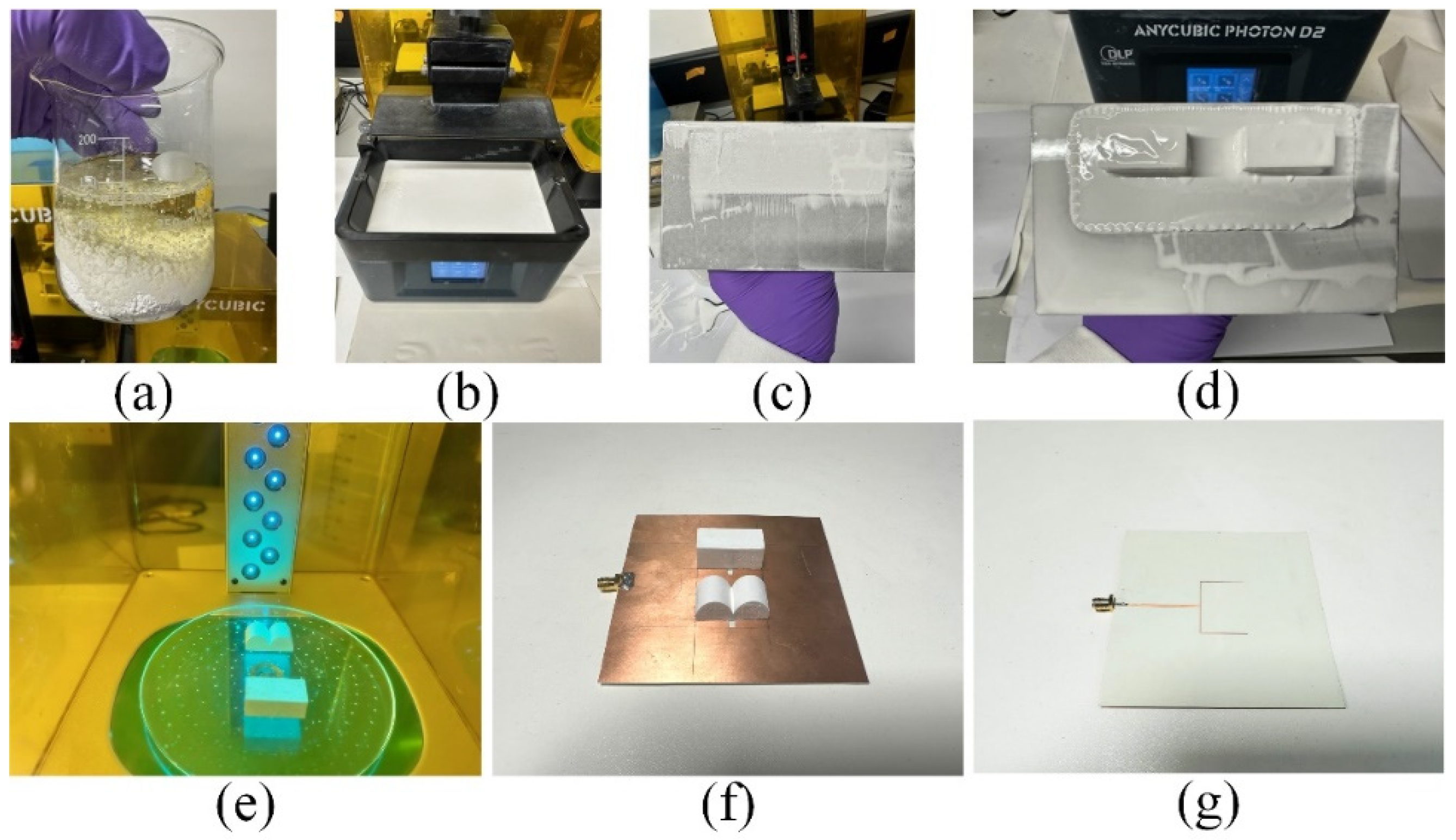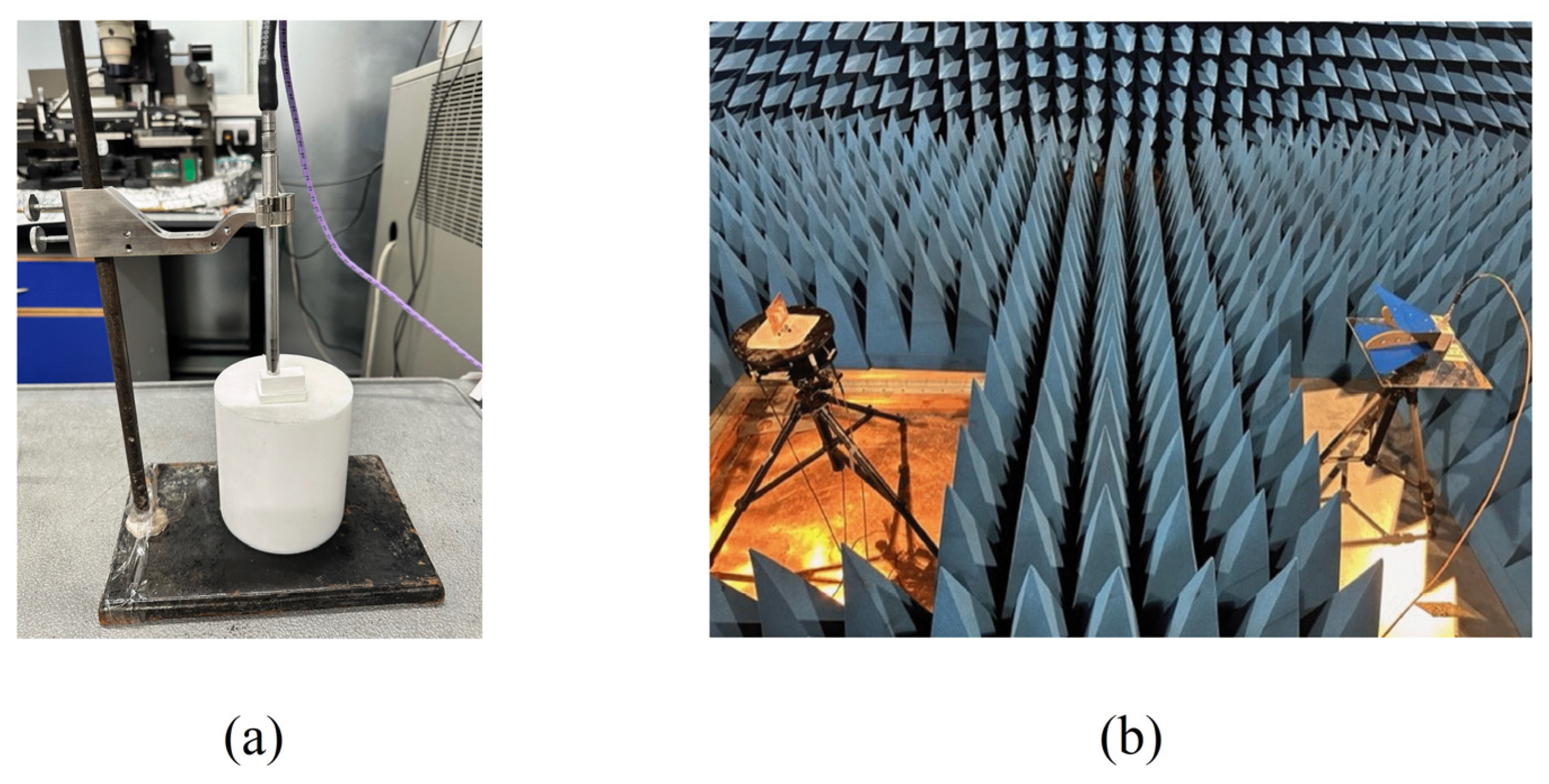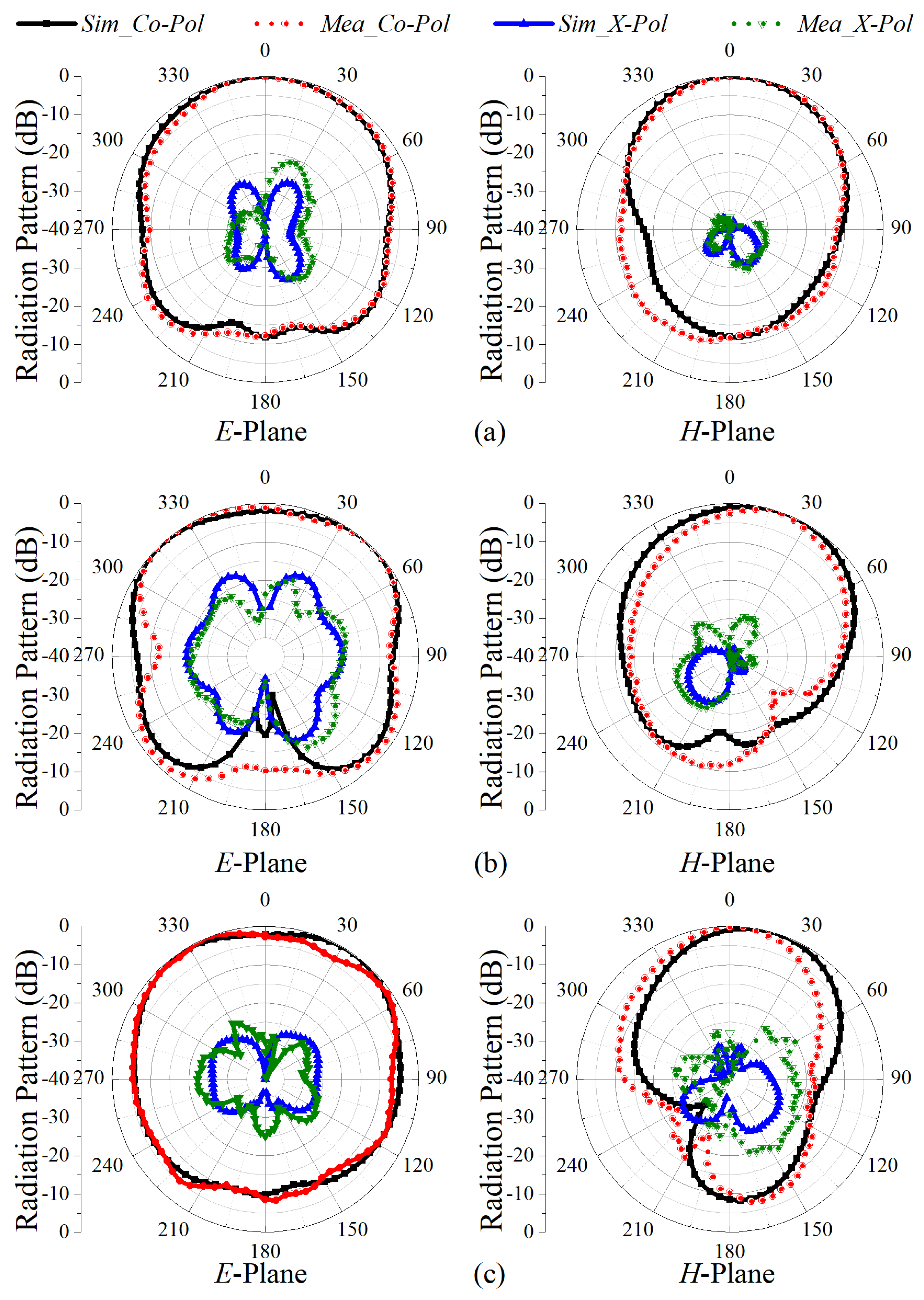Three-Dimensionally Printed Dual-Slot-Fed Dielectric Resonator Antenna with Rectangular and Irregular Elements for 5G Applications
Abstract
1. Introduction
2. Antenna Configuration and Simulations
2.1. Configuration of Slot-Fed Single-Element DRAs
2.2. Equivalent Circuits of Slot-Fed Single-Element DRAs
2.3. Configuration of Dual-Slot-Fed Two-Element DRA
3. Experimental Verification: Fabrication and Measurements
3.1. DLP-Based 3D Printing Process
3.2. Measured Dielectric Property and Antenna Properties
4. Conclusions
Author Contributions
Funding
Data Availability Statement
Conflicts of Interest
References
- Petosa, A. Dielectric Resonator Antenna Handbook; Artech House Antennas and Propagation Library; Artech House: Boston, MA, USA, 2007; ISBN 1596932066. [Google Scholar]
- Pan, Y.M.; Zheng, S.Y. A Low-Profile Stacked Dielectric Resonator Antenna with High-Gain and Wide Bandwidth. IEEE Antennas Wirel. Propag. Lett. 2016, 15, 68–71. [Google Scholar] [CrossRef]
- Sun, W.-J.; Yang, W.-W.; Chu, P.; Chen, J.-X. Design of a Wideband Circularly Polarized Stacked Dielectric Resonator Antenna. IEEE Trans. Antennas Propag. 2019, 67, 591–595. [Google Scholar] [CrossRef]
- Xia, Z.-X.; Leung, K.W. 3-D-Printed Wideband Circularly Polarized Dielectric Resonator Antenna with Two Printing Materials. IEEE Trans. Antennas Propag. 2022, 70, 5971–5976. [Google Scholar] [CrossRef]
- Thamae, L.Z.; Wu, Z. Broadband Bowtie Dielectric Resonator Antenna. IEEE Trans. Antennas Propag. 2010, 58, 3707–3710. [Google Scholar] [CrossRef]
- Varshney, G.; Pandey, V.S.; Yaduvanshi, R.S.; Kumar, L. Wide Band Circularly Polarized Dielectric Resonator Antenna with Stair-Shaped Slot Excitation. IEEE Trans. Antennas Propag. 2017, 65, 1380–1383. [Google Scholar] [CrossRef]
- Fakhte, S.; Oraizi, H.; Karimian, R.; Fakhte, R. A New Wideband Circularly Polarized Stair-Shaped Dielectric Resonator Antenna. IEEE Trans. Antennas Propag. 2015, 63, 1828–1832. [Google Scholar] [CrossRef]
- Lu, L.; Jiao, Y.-C.; Liang, W.; Zhang, H. A Novel Low-Profile Dual Circularly Polarized Dielectric Resonator Antenna. IEEE Trans. Antennas Propag. 2016, 64, 4078–4083. [Google Scholar] [CrossRef]
- Pan, Y.; Leung, K.W. Wideband Circularly Polarized Trapezoidal Dielectric Resonator Antenna. IEEE Antennas Wirel. Propag. Lett. 2010, 9, 588–591. [Google Scholar] [CrossRef]
- Fakhte, S.; Matekovits, L. Controlling Frequency Distance between Individual Modes of Dielectric Resonator Nanoantenna Using Uniaxial Anisotropic Materials. Radiat. Phys. Chem. 2022, 190, 109812. [Google Scholar] [CrossRef]
- Afifi, A.I.; Abdel-Rahman, A.B.; El-Hameed, A.S.A.; Allam, A.; Ahmed, S.M. Small Frequency Ratio Multi-Band Dielectric Resonator Antenna Utilizing Vertical Metallic Strip Pairs Feeding Structure. IEEE Access 2020, 8, 112840–112845. [Google Scholar] [CrossRef]
- So, K.K.; Leung, K.W.; Li, B. Frequency Tuning and Bandwidth Enhancement of the Dielectric Resonator Antenna with a Parasitic Rectangular Slot. In Proceedings of the 2005 IEEE Antennas and Propagation Society International Symposium, Washington, DC, USA, 3–8 July 2005; IEEE: Piscataway, NJ, USA, 2005; Volume 4B, pp. 234–237. [Google Scholar]
- Ng, H.K.; Leung, K.W. Frequency Tuning of the Linearly and Circularly Polarized Dielectric Resonator Antennas Using Multiple Parasitic Strips. IEEE Trans. Antennas Propag. 2006, 54, 225–230. [Google Scholar] [CrossRef]
- Hao, C.X.; Li, B.; Leung, K.W.; Sheng, X.Q. Frequency-Tunable Differentially Fed Rectangular Dielectric Resonator Antennas. IEEE Antennas Wirel. Propag. Lett. 2011, 10, 884–887. [Google Scholar] [CrossRef]
- Yang, N.; Leung, K.W.; Wu, N. Pattern-Diversity Cylindrical Dielectric Resonator Antenna Using Fundamental Modes of Different Mode Families. IEEE Trans. Antennas Propag. 2019, 67, 6778–6788. [Google Scholar] [CrossRef]
- Hu, P.F.; Pan, Y.M.; Zhang, X.Y.; Hu, B.J. A Compact Quasi-Isotropic Dielectric Resonator Antenna with Filtering Response. IEEE Trans. Antennas Propag. 2019, 67, 1294–1299. [Google Scholar] [CrossRef]
- Chen, Z.; Li, Z.; Li, J.; Liu, C.; Lao, C.; Fu, Y.; Liu, C.; Li, Y.; Wang, P.; He, Y. 3D Printing of Ceramics: A Review. J. Eur. Ceram. Soc. 2019, 39, 661–687. [Google Scholar] [CrossRef]
- Chen, H.; Guo, L.; Zhu, W.; Li, C. Recent Advances in Multi-Material 3D Printing of Functional Ceramic Devices. Polymers 2022, 14, 4635. [Google Scholar] [CrossRef]
- Huang, J.; Chen, S.J.; Xue, Z.; Withayachumnankul, W.; Fumeaux, C. Impact of Infill Pattern on 3D Printed Dielectric Resonator Antennas. In Proceedings of the 2018 IEEE 7th Asia-Pacific Conference on Antennas and Propagation, APCAP 2018, Auckland, New Zealand, 5–8 August 2018; pp. 233–235. [Google Scholar] [CrossRef]
- Xia, Z.X.; Leung, K.W.; Lu, K. 3-D-Printed Wideband Multi-Ring Dielectric Resonator Antenna. IEEE Antennas Wirel. Propag. Lett. 2019, 18, 2110–2114. [Google Scholar] [CrossRef]
- Chietera, F.P.; Colella, R.; Catarinucci, L. Dielectric Resonators Antennas Potential Unleashed by 3D Printing Technology: A Practical Application in the IoT Framework. Electronics 2022, 11, 64. [Google Scholar] [CrossRef]
- Basile, V.; Grande, M.; Marrocco, V.; Laneve, D.; Petrignani, S.; Prudenzano, F.; Fassi, I. Design and Manufacturing of Super-Shaped Dielectric Resonator Antennas for 5G Applications Using Stereolithography. IEEE Access 2020, 8, 82929–82937. [Google Scholar] [CrossRef]
- Morales, C.D.; Morlaas, C.; Chabory, A.; Pascaud, R.; Grzeskowiak, M.; Mazingue, G. 3D-printed Ceramics with Engineered Anisotropy for Dielectric Resonator Antenna Applications. Electron. Lett. 2021, 57, 679–681. [Google Scholar] [CrossRef]
- Lou, Y.; Wang, F.; Li, Z.; Zou, Z.; Fan, G.; Wang, X.; Lei, W.; Lu, W. Fabrication of High-Performance MgTiO3–CaTiO3 Microwave Ceramics through a Stereolithography-Based 3D Printing. Ceram. Int. 2020, 46, 16979–16986. [Google Scholar] [CrossRef]
- Sotov, A.; Kantyukov, A.; Popovich, A.; Sufiiarov, V. LCD-SLA 3D Printing of BaTiO3 Piezoelectric Ceramics. Ceram. Int. 2021, 47, 30358–30366. [Google Scholar] [CrossRef]
- Wang, F.; Li, Z.; Lou, Y.; Zeng, F.; Hao, M.; Lei, W.; Wang, X.; Wang, X.; Fan, G.; Lu, W. Stereolithographic Additive Manufacturing of Luneburg Lens Using Al2O3-Based Low Sintering Temperature Ceramics for 5G MIMO Antenna. Addit. Manuf. 2021, 47, 102244. [Google Scholar] [CrossRef]
- Tian, T.; Huang, X.; Xu, Y.; Liu, P.; Liu, C.; Hu, N.; Zhang, J.; Wu, Z. A Wideband Energy Selective Surface with Quasi-Elliptic Bandpass Response and High-Power Microwave Shielding. IEEE Trans. Electromagn. Compat. 2023, 66, 224–233. [Google Scholar] [CrossRef]
- Zeng, Z.; Bai, L. A Compact Bandwidth and Frequency-Range Reconfigurable CM Filter Using Varactor-Loaded Dual-Slot-Based Defected Ground Structure. IEEE Trans. Electromagn. Compat. 2023, 65, 725–737. [Google Scholar] [CrossRef]
- Zhang, Z.-Y.; Ding, C.F.; Zeng, Y.; Su, H.; Zhou, T.; Zhang, X.Y.; Yu, M. Circuit Model for N Th-Order Filtering Wire Antenna, Parameter Extraction, and Radiation Prediction. IEEE Trans. Microw. Theory Tech. 2023, 71, 3945–3957. [Google Scholar] [CrossRef]
- Kishk, A.A.; Zhang, X.; Glisson, A.W.; Kajfez, D. Numerical Analysis of Stacked Dielectric Resonator Antennas Excited by a Coaxial Probe for Wideband Applications. IEEE Trans. Antennas Propag. 2003, 51, 1996–2006. [Google Scholar] [CrossRef]
- Olokede, S.S.; Adamariko, C.A.; Qasaymeh, Y.M. Equivalent Circuit Model of a Coaxial Excited Microstrip-fed Quasi-lumped Element Resonator Antenna Array. IET Microw. Antennas Propag. 2015, 9, 446–453. [Google Scholar] [CrossRef]
- Qasaymeh, Y.; Almuhaisen, A. Miniaturized Reconfigurable Dielectric Resonator Antenna Array with Reduced Beam Squinting. Int. J. RF Microw. Comput.-Aided Eng. 2022, 32, e23491. [Google Scholar] [CrossRef]
- Iqbal, A.; Alazemi, A.J.; Mallat, N.K. Slot-DRA-Based Independent Dual-Band Hybrid Antenna for Wearable Biomedical Devices. IEEE Access 2019, 7, 184029–184037. [Google Scholar] [CrossRef]
- Wang, H.; Zheng, M. A Triple-Band WLAN Monopole Antenna. IET Semin. Dig. 2007, 2007. [Google Scholar] [CrossRef]
- Kumar Mongia, R.; Ittipiboon, A. Theoretical and Experimental Investigations on Rectangular Dielectric Resonator Antennas. IEEE Trans. Antennas Propag. 1997, 45, 1348–1356. [Google Scholar] [CrossRef]
- Davis, L.E.; Wu, Z. Automation-Orientated Techniques for Quality-Factor Measurement: Of High-Tc Superconducting Resonators. IEE Proc.-Sci. Meas. Technol. 1994, 141, 527–530. [Google Scholar] [CrossRef]
- Yang, T.; Ren, J.; Zhang, B.; Liu, Y.-T.; Ma, T.; Yin, Y. Wideband Diversity Cylindrical Dielectric Resonator Antenna Based on Multimode Resonance. IEEE Antennas Wirel. Propag. Lett. 2023, 22, 2205–2209. [Google Scholar] [CrossRef]
- Fang, X.S.; Weng, L.P.; Fan, Z. Design of the Wideband and Low-Height Omnidirectional Cylindrical Dielectric Resonator Antenna Using Arced-Apertures Feeding. IEEE Access 2023, 11, 20128–20135. [Google Scholar] [CrossRef]
- Dwivedy, B. A Droplet-Shape Inspired Wideband Bow-Tie Dielectric Resonator Antenna for Sub-6 GHz and IoT Applications. AEU-Int. J. Electron. Commun. 2024, 178, 155281. [Google Scholar] [CrossRef]
- Rad, M.; Nikkhah, N.; Zakeri, B.; Yazdi, M. Wideband Dielectric Resonator Antenna with Dual Circular Polarization. IEEE Trans. Antennas Propag. 2021, 70, 714–719. [Google Scholar] [CrossRef]













| DRA | Frequency of Mode | Frequency Ratio | |
|---|---|---|---|
| (quasi-)TEy111 | (quasi-)TEy211 | ||
| DRA-00 | 3.43 GHz | 4.94 GHz | 1.440 |
| DRA-20 Rx = 20 mm | 3.46 GHz | 4.955 GHz | 1.432 |
| DRA-20 Rx = 12 mm | 3.54 GHz | 4.98 GHz | 1.407 |
| DRA-20 Rx = 10 mm | 3.615 GHz | 5.005 GHz | 1.385 |
| DRA-20 Rx = 8 mm | 3.845 GHz | 5.01 GHz | 1.303 |
| DRA-20 Rx = 7.8 mm | 3.9 GHz | 5.005 GHz | 1.283 |
| DRA-20 Rx = 7.5 mm | 4.02 GHz | 5 GHz | 1.244 |
| Parameters | DRA-00 | DRA-20, Rx = 7.8 mm | |||
|---|---|---|---|---|---|
| SRLC1 | SRLC2 | SRLC1 | SRLC2 | ||
| RLC Values | R (Ω) | 41.2953 | 48.9513 | 39.3250 | 94.4101 |
| L (nH) | 14.5306 | 17.8877 | 11.5217 | 23.7810 | |
| C (pF) | 0.1482 | 0.0580 | 0.1445 | 0.0425 | |
| Freq (GHz) | CST | 3.43 | 4.94 | 3.9 | 5.005 |
| ADS | 3.46 | 4.89 | 3.96 | 4.94 | |
| Parameters | Values | Parameters | Values | Parameters | Values |
|---|---|---|---|---|---|
| a1 | 30 mm | Ly | 14 mm | Wf1 | 1.12 mm |
| b1 | 22 mm | Wsub | 100 mm | Wf2 | 0.3 mm |
| d | 12 mm | Lsub | 100 mm | L1 | 41 mm |
| εr | 8 | Hsub | 0.508 mm | L2 | 15 mm |
| Rx | 7.8 mm | Wslot | 2.6 mm | Ls | 9 mm |
| Rz | 12 mm | Lslot | 21 mm | s | 13 mm |
| Ref. | Freq (GHz) | εr | Antenna Type | Bandwidth |
|---|---|---|---|---|
| [6] | 4.1–6.81 | 12.8 | Rectangular and half-cylindrical DRA with stair-shaped slot | 49.67% |
| [37] | 3.08–4.16 | 9.5 | Wheel-shaped DRA | 30% |
| [38] | 4.88–6.88 | 6.85 | Cylindrical DRA with arced aperture | 34% |
| [39] | 3.18–4.91 | 9.8 | Droplet-shaped bowtie DRA with balun-fed aperture | 42.7% |
| [40] | 8.5–12 | 20 | Cylindrical DRA | 34% |
| This paper | 2.96–5.02 | 8 | RDRA and irregular DRA with dual slots | 51.6% |
Disclaimer/Publisher’s Note: The statements, opinions and data contained in all publications are solely those of the individual author(s) and contributor(s) and not of MDPI and/or the editor(s). MDPI and/or the editor(s) disclaim responsibility for any injury to people or property resulting from any ideas, methods, instructions or products referred to in the content. |
© 2024 by the authors. Licensee MDPI, Basel, Switzerland. This article is an open access article distributed under the terms and conditions of the Creative Commons Attribution (CC BY) license (https://creativecommons.org/licenses/by/4.0/).
Share and Cite
Shou, Z.; Wu, Z.; Wang, H.; Zhou, H.; Hou, M. Three-Dimensionally Printed Dual-Slot-Fed Dielectric Resonator Antenna with Rectangular and Irregular Elements for 5G Applications. Electronics 2024, 13, 4903. https://doi.org/10.3390/electronics13244903
Shou Z, Wu Z, Wang H, Zhou H, Hou M. Three-Dimensionally Printed Dual-Slot-Fed Dielectric Resonator Antenna with Rectangular and Irregular Elements for 5G Applications. Electronics. 2024; 13(24):4903. https://doi.org/10.3390/electronics13244903
Chicago/Turabian StyleShou, Zhenyi, Zhipeng Wu, Hanyang Wang, Hai Zhou, and Meng Hou. 2024. "Three-Dimensionally Printed Dual-Slot-Fed Dielectric Resonator Antenna with Rectangular and Irregular Elements for 5G Applications" Electronics 13, no. 24: 4903. https://doi.org/10.3390/electronics13244903
APA StyleShou, Z., Wu, Z., Wang, H., Zhou, H., & Hou, M. (2024). Three-Dimensionally Printed Dual-Slot-Fed Dielectric Resonator Antenna with Rectangular and Irregular Elements for 5G Applications. Electronics, 13(24), 4903. https://doi.org/10.3390/electronics13244903






